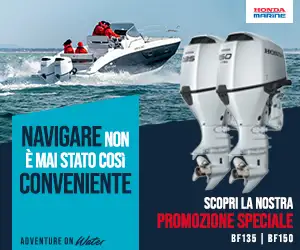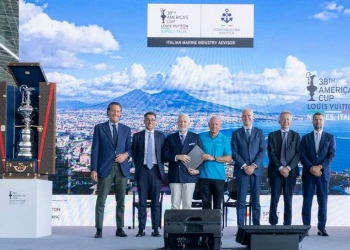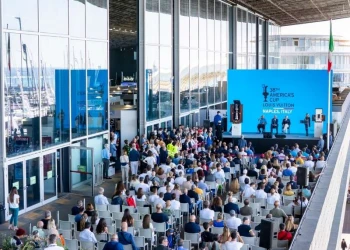
©Paul Todd/America's Cup
The NYYC American Magic's high speed magicians
They call themselves ‘American Magic’ and after a thrilling 1st April session there was simply no doubt that technical sorcery and sailing craft of the highest order were on display out on an initially foggy, misty, spooky Pensacola Bay. No April Fools, when the mist cleared, this was top drawer sailing from two of the finest foiling sailors of a generation in Paul Goodison and Tom Slingsby who both transitioned so effortlessly to flight from a thorough and decorated schooling in displacement dinghies. Today they put everything into a session where the memo clearly stated: ‘push this to the limits.’
The outer edge of possibility was found and as Goodison said afterwards in interview: “That was way faster than we’ve been before.” Speeds touching the magic 50 knot barrier were attained whilst riding the new starboard anhedral foil but there was a pervading sense that the sailors wanted more. Riding at these speeds rewards pin-point accuracy but in training, pushing beyond the limit is where you find the pot of gold that is improvement. Several nosedives were the result with the AC40 standing up brilliantly to the severe stress that the team are placing on ‘America’ now in full-on LEQ12 development mode. On one final stuff, the force of the water was so strong that it ripped Paul Goodison’s goggles from his helmet. That’s pushing it.
Paul Goodison, always a peerless interviewee, spoke to Mike Pedersen of the recon unit after sailing and contextualised the day, saying: “We wanted to push the new foil wing pretty hard and see how fast we could go, so we chose to take it on today and we’ve seen some pretty high gusts up there and doing some really nice speeds. It was really good just to get a feel for the difference between the two boards how they accelerate and their top speeds …We were seeing over 20 knots (of breeze) and we came pretty close to 50 knots just at the end there on the new foil which is pretty impressive.”

The Americans have been pushing hard into the starboard foil data, determined to gather the maximum they can and benchmark it to the standard AC40 foil they are running on the port arm. Paul summed it up saying: “Each board is slightly different in style so you need different settings between the boards - one obviously likes the cant slightly different and the other one likes the pitch slightly different so we were playing around just basically learning the foils and at the end there to go around some marks and push a bit harder you learn very quickly what works and what doesn't work, so a great learning day for us.”
Talking about the mode variations that were obvious to see, especially on the longer runs, Paul commented: “You saw upwind we were trying a couple of different modes and then just checking in between the two foils as to how soft they are around at their optimum and getting a good feel for what works.”

When pushed about the team’s new AC75, Paul opened the design door slightly ajar as he said: “We haven't quite signed off on final designs for the AC75 that's why it's so important at the moment we're getting out and getting the hours in on the boat so that we can really feed those final decisions and then get the fastest 75 possible…I think it (the Cup) will be much closer than the previous ones. Obviously with it being the second generation of boats everybody comes closer together and when you look towards Barcelona being wavy and lighter winds, I think the sailing is going to come into play and play a really big part in it.”
American Magic have pushed harder than any other challenger team in winter training and the results are there before our eyes. The high-speed magicians just get better and better. It’s a privilege to watch.





